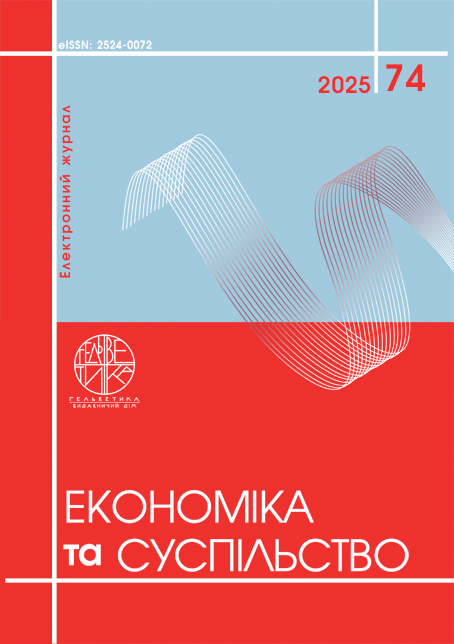THE ROLE OF DIGITALIZATION OF HUMAN RESOURCE MANAGEMENT IN REDUCING EMPLOYEE TURNOVER
Abstract
The purpose of this article is to examine how digitalization in human resource management (HRM) processes affects the reduction of employee turnover in international organizations. The relevance of this topic is linked to increasing instability in global labor markets, rising competition for skilled professionals, and the necessity to strengthen organizational resilience through effective personnel strategies. Employee turnover continues to impose serious operational and financial risks on businesses, prompting a shift from reactive to proactive workforce management supported by modern technology and data-based tools. The research methodology is based on analytical modeling, structural-functional analysis, and evaluation of practical digital HR solutions targeted at turnover prevention. The study applies qualitative assessment of systems that use artificial intelligence, big data, and automation tools to monitor behavioral trends, engagement levels, and internal career mobility. These methods make it possible to assess the potential of digital platforms to support decision-making in employee retention strategies, optimize HR workflows, and enhance long-term staff development. The findings confirm that digital HR tools facilitate early identification of risk factors associated with turnover, such as reduced job satisfaction, stagnation in development, or lack of feedback from leadership. Through intelligent systems for tracking performance, managing benefits, and improving communication with employees, companies can lower attrition rates and foster long-term employee commitment and satisfaction. The practical value of this article lies in the proposed framework for integrating digital tools into HR strategies to reduce turnover, improve employee experience, and increase adaptability in a changing business environment. The results of this study may serve as a guide for HR professionals and company leaders interested in building data-driven, future-oriented approaches to personnel, ensure knowledge retention, and support workforce stability.
References
Qawasmeh E. F., Qawasmeh F., Daoud M. K. Digital Transformation in HRM: Leveraging AI and Big Data for Employee Engagement and Retention // Journal of Ecohumanism. – 2024. – Vol. 3, No. 3. – P. 2044–2051.
Zhang J., Chen Z. Exploring Human Resource Management Digital Transformation in the Digital Age // Journal of the Knowledge Economy. – 2023. – DOI: https://doi.org/10.1007/s13132-023-01214-y.
Marín-Díaz G., Galán-Hernández J. J., Galdón-Salvador J. L. Analyzing Employee Attrition Using Explainable AI for Strategic HR Decision-Making // Mathematics. – 2023. – Vol. 11, No. 22. – Article 4677. – DOI: https://doi.org/10.3390/math11224677.
Eickemeyer S. C., Bernhardt D., Boos K., та ін. Acting Instead of Reacting – Ensuring Employee Retention during Successful Introduction of I4.0 // Applied System Innovation. – 2021. – Vol. 4, No. 4. – Article 97. – DOI: https://doi.org/10.3390/asi4040097.
García-Fernández L., Ortiz-de-Urbina-Criado M., García-López M. J. Mapping the Main Research Themes in Digital Human Resources // Humanities & Social Sciences Communications. – 2024. – Vol. 11, No. 1. – DOI: https://doi.org/10.1057/s41599-024-03795-8.
Кормщикова Н. І. Вплив цифровізації на ефективність управління персоналом в сучасних умовах [Електронний ресурс]. – Режим доступу: https://mpeproc.fmm.kpi.ua/article/view/298316.
Ketolainen N. Digitalization of Human Resources – the Transformation Journey into Automated and Data-Driven Service Organization [Електронний ресурс]. – Haaga-Helia University of Applied Sciences, 2018. – Режим доступу: https://www.academia.edu/116540896.
World Economic Forum. HR 4.0: Shaping People Strategies in the Fourth Industrial Revolution. – Cologny/Geneva: World Economic Forum, 2019. – URL: https://www.weforum.org/publications/hr4-0-shaping-people-strategies-in-the-fourth-industrial-revolution.
Gallup. State of the Global Workplace 2025. – Washington, D.C.: Gallup Press, 2025. – URL: https://www.gallup.com/workplace/349484/state-of-the-global-workplace.aspx.
Gallup. Global Indicator: Employee Retention & Attraction. – Washington, D.C.: Gallup Press, 2024. – URL: https://www.gallup.com/467702/indicator-employee-retention-attraction.aspx.
Gallup. 42% of Employee Turnover Is Preventable but Often Ignored. – Washington, D.C.: Gallup Press, 2024. – URL: https://www.gallup.com/workplace/646538/employee-turnover-preventable-often-ignored.aspx.
Gallup. The World’s $8.8 Trillion Workplace Problem. – Washington, D.C.: Gallup Press, 2023. – URL: https://www.gallup.com/workplace/393497/world-trillion-workplace-problem.aspx.
Qawasmeh, E. F., Qawasmeh, F., & Daoud, M. K. (2024). Digital transformation in HRM: Leveraging AI and big data for employee engagement and retention. Journal of Ecohumanism, 3(3), 2044–2051.
Zhang, J., & Chen, Z. (2023). Exploring human resource management digital transformation in the digital age. Journal of the Knowledge Economy. https://doi.org/10.1007/s13132-023-01214-y
Marín-Díaz, G., Galán-Hernández, J. J., & Galdón-Salvador, J. L. (2023). Analyzing employee attrition using explainable AI for strategic HR decision-making. Mathematics, 11(22), 4677. https://doi.org/10.3390/math11224677
Eickemeyer, S. C., Bernhardt, D., Boos, K., et al. (2021). Acting instead of reacting – Ensuring employee retention during successful introduction of I4.0. Applied System Innovation, 4(4), 97. https://doi.org/10.3390/asi4040097
García-Fernández, L., Ortiz-de-Urbina-Criado, M., & García-López, M. J. (2024). Mapping the main research themes in digital human resources. Humanities & Social Sciences Communications, 11(1). https://doi.org/10.1057/s41599-024-03795-8
Kormshchykova, N. I. (n.d.). The impact of digitalization on the efficiency of human resource management in modern conditions. Retrieved from https://mpeproc.fmm.kpi.ua/article/view/298316
Ketolainen, N. (2018). Digitalization of human resources – The transformation journey into automated and data-driven service organization [Bachelor’s thesis, Haaga-Helia University of Applied Sciences]. Academia.edu. https://www.academia.edu/116540896
World Economic Forum. (2019). HR 4.0: Shaping people strategies in the Fourth Industrial Revolution. Cologny/Geneva: World Economic Forum. https://www.weforum.org/publications/hr4-0-shaping-people-strategies-in-the-fourth-industrial-revolution
Gallup. (2025). State of the global workplace 2025. Washington, D.C.: Gallup Press. https://www.gallup.com/workplace/349484/state-of-the-global-workplace.aspx
Gallup. (2024). Global indicator: Employee retention & attraction. Washington, D.C.: Gallup Press. https://www.gallup.com/467702/indicator-employee-retention-attraction.aspx
Gallup. (2024). 42% of employee turnover is preventable but often ignored. Washington, D.C.: Gallup Press. https://www.gallup.com/workplace/646538/employee-turnover-preventable-often-ignored.aspx
Gallup. (2023). The world’s $8.8 trillion workplace problem. Washington, D.C.: Gallup Press. https://www.gallup.com/workplace/393497/world-trillion-workplace-problem.aspx

This work is licensed under a Creative Commons Attribution 4.0 International License.


